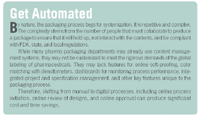Direct to Consumer: Perfect Package
The ideal healthcare package, in addition to reflecting the quality of the product it contains, fortifies brand equity and differentiates the product in the marketplace.
The pharmaceutical industry is well known for the rigor it applies to the legal, manufacturing, research and development, and regulatory processes that dominate its day-to-day business. Now it's time for pharma marketers to apply the same intellectual process and rigor to all forms of marketing—from direct-to-consumer advertising to packaging. Currently, the pharma industry is significantly lagging behind the consumer industry in regard to employing best packaging practices and technologies. Innovative packaging is prevalent among the consumer industry—from Coca Cola's Fridge Master, a convenient carton that allows for more compact storage, to Ensure, the nutraceutical beverage that saw increased market share when it switched from glass to easy-to-open plastic bottles. Packaging matters to the consumer—be it in a consumable good or a pharmaceutical product.

Gordon Wade
Sense of Purpose
At the most basic level, packaging describes the product it contains, including its benefits and risks, and preserves it safely until it is purchased and used. Packaging is about applying new combinations of materials and technologies to promote consumer and patient education, safety, and compliance, while reinforcing product quality and brand image. One need only look at a country where packaging is not mature to realize its importance. In China, for example, it is estimated that over 40 percent of all
consumables spoil or are damaged beyond use before they even reach the buying public.
Good labeling and packaging should serve many functions. Both should accurately represent the contents (both package and inserts), serve as a template for future design projects, be easily re-purposed for use in other languages, have necessary counterfeit protection, and be creative in their design.

Kent St.Vrain
Another compelling reason to improve packaging is to avoid FDA recalls. FDA stated recently that in a six-month period, 64 percent of FDA recalls occurred either as a result of mislabeling or faulty packaging. These numbers convey that one way to reliably avoid two-thirds of issues associated with recalls, as well as the concomitant bad press and high costs, is to consistently produce good labeling and packaging.
Brand Loyalty
Packaging also has the ability to solidify patient loyalty to the brand. For patients, the package is the product. It's the tangible manifestation of an often emotionally charged relationship to a brand. The ideal healthcare package, in addition to reflecting the quality of the product it contains, fortifies brand equity and differentiates the product in the marketplace. What's more, the ideal healthcare package is memorable to physicians and pharmacists—both of whom influence patients' product choices.
As drugs increasingly become available over the counter, shelf appeal and brand identity become a greater concern as products fight for consumers' attention. The need for eye-catching graphics and design also plays a role in prescription medication, given the high number of drugs being advertised to the consumer. And as a product's patent expires and the medication is released as a generic, the loyalty built through years of strong branding can extend the product's life.

Get Automated
Compliance
The package's design, in particular, can affect patience compliance. A recently released two-year study from Ohio State University's College of Pharmacy documented that packaging improvements resulted in better patient health outcomes, compliance, and a financial payoff with a greater likelihood that the patient would refill the prescription. The study found that patients taking blood-pressure medication delivered in blister packs had a more efficacious outcome, based on better compliance to the prescribed regime, than those that took loose pills. Forty-eight percent of patients using the blister-pack method of packaging had lowered blood pressure, while only 18 percent of those who took loose pills had this effect. Furthermore, 80 percent of patients refilled their blister-pack prescriptions on time, whereas only 66 percent of patients refilled their loose-pill prescriptions on time.
The benefit of the blister-packaging format is that it can easily be printed to provide specific time-of-day doses as well as day-by-day dates on the package. It can also include a placebo for days off medication. At its core, it's easy to use. Also, as the population ages, more and more consumers are taking multiple medications—typically up to as many as five prescription drugs per day. So simplifying what to take at what time, and on what day, reduces patient confusion.
While blister and dose packs aren't new, they've previously been confined to delivery of short-term medications and OTC (with birth control as a clear exception to the trend). The primary drivers behind loose packaging have been cost containment. While the cost differential varies widely by volume of the drug dispensed (as the set-up costs are amortized over the quantities produced), loose packaging is overall said to be more cost-effective. In addition, many manufacturing facilities for ethical drug production are presently set up with costly machinery that is tooled for bulk packaging.
Unit dosing also improves drug quality and potential outcomes. By reducing the number of steps involved in the creation and delivery of the medication, it creates less opportunity for either human or system error. Because unit packaging is created in a manufacturing facility, no counting or re-packaging is needed at a pharmacy—it goes straight to the consumer.
Sample-Pack Power
Physician sample packs could also benefit from packaging innovations. Accounting for an estimated 55 percent of pharmaceutical-marketing spending, according to IMS Health, sample packs are often in the form of unit dosing, boasting smaller quantities and detailed instructions, and more recently, quality-of-life questionnaires. These questionnaires provide patients a convenient, directive method for recording side effects and other responses to their medications. They can be mailed directly to the pharmaceutical manufacturer or given to a doctor.
Furthermore, IMS Health found that 25 percent of physicians say they will not prescribe medicine until they have received samples. Physicians have long regarded samples as an important part of patient service. Sample packs are yet another opportunity to brand and simultaneously increase physician and patient loyalty.
Accounts
KV Pharmaceutical Company selected Vitaflo Scandinavia AB to market two new women's health products. • Access Communications Inc.will market Pfizer's Lyrica to Fortune 500 companies and labor unions. • Bard Advertising was named the agency of record for GT Urological. • Clearant, a biotech company in Los Angeles selected EPIC Brand Communications as its agency of record for the Clearant Process. • Media Research Planning and Placement is the agency of record for the Cancer Centers of North Carolina. • Publicis Groupe acquired a 50-percent stake in Freud Communications.

Amie Casson
People
CHS added Philip Grinnell and Ken Wilson to their marketing team. • Amie Casson joined Abelson-Taylor as senior account supervisor. She will handle Neulasta, an Amgen product. • The Patient Marketing Group hired Rich Britton as senior account manager. • Mary Beliveau joined MC Communications as senior vice president of marketing. • Phase Forward hired Pam Randhawa as vice president of marketing. • Healthstar hired John Quick as director of client services. • Lanmark Group promoted Kurt Algayer to vice president of creative services. • Jim Heekin was hired as chairman and CEO of Grey Worldwide.

Mary Beliveau
Awards
Fairleigh Dickinson University's Alumni Association gave Gil Bashe, EVP in Makovsky & Company's health practice, its Elia G. Stratis Castle Award.
Gordon Wade is the founding partner of EMM group. He can be reached at gordonwade@emmgroup.net
Kent St.Vrain is vice president of sales and marketing for Paxonix, Inc. He can be reached at kent.stvrain@paxonix.com

The Misinformation Maze: Navigating Public Health in the Digital Age
March 11th 2025Jennifer Butler, chief commercial officer of Pleio, discusses misinformation's threat to public health, where patients are turning for trustworthy health information, the industry's pivot to peer-to-patient strategies to educate patients, and more.
Navigating Distrust: Pharma in the Age of Social Media
February 18th 2025Ian Baer, Founder and CEO of Sooth, discusses how the growing distrust in social media will impact industry marketing strategies and the relationships between pharmaceutical companies and the patients they aim to serve. He also explains dark social, how to combat misinformation, closing the trust gap, and more.